#Print literary Magazines
Note
Hi! Congrats on the book — I'm going to get a copy when I'm able but question: what is a spot illustration?
extra illustrations to fill blank space on pages! my zine has them on the front and back inner covers and at the bottom of my little note in the back :) basically it's just some extra art of mine that you're getting in what would otherwise be empty space!
#if you've ever read like. ok this makes me sound old. but if you read like physical printed literary magazines#they sometimes have art and stuff in the margins between stories/paragraphs/whatever. the new yorker still has them i think?#that's traditionally what a spot illustration is but it's really just any little illustration that fills empty space!#asks
29 notes
·
View notes
Text
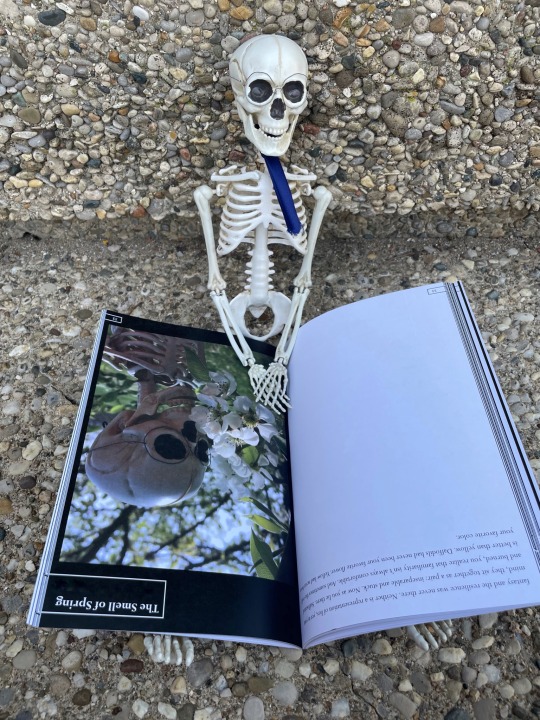
I can't believe I can see myself in print.
#skeleton#plastic skeleton#halloween#halloween decorations#photo#magazine#journal#literary and arts journal#arts journal#art#print#in print#creativity#published#im so excited#i cant believe it#the smell of spring#stop and smell the flowers
12 notes
·
View notes
Text
WINNERS! of the 2023 Force Majeure Flash Contest — full announcement: https://wp.me/p1tViT-19z
1st Prize "Pre-Elegy for My Sister" by Whitney Koo
2nd Prize "A Brief World" by Uyen P. Dang
2nd Prize "Bones" by Nathan Long
honorable mentions: "Garden Statues" by Kendall Morris, "Midnight Zone" by Caleb Tankersley, and "Taint" by Veeda Khan.
#flash#flash fiction#short story#flash CNF#flash nonfiction#literary magazine#print magazine#writing#contest#winners#prizes#honorable mention
2 notes
·
View notes
Text
We Are The Minison Project
We’ve decided to bite the bullet and join the gremlins here on tumblr!
Who are we? Hmm, yeah… guess we should have started with that.
The Minison Project is technically an independent literary organization, but you’ll see us refer to ourselves as a literary magazine! Founded in 2020 by Melissa Ashley Hernandez, our small indie team runs a few projects throughout the year:
> the minison zine — a zine originally based on the “minison” poetry form (a form created by Tom Snarsky and Jo Ianni.) Now we include all different variations of the form, including sonnets!
> TMP Magazine — A classic literary magazine dedicated to publishing all kinds of work from literary pieces to visual art (yes, that includes comics!)
> Blog — Our blog where we post articles, interviews, movie/song/book reviews, editorials, etc. We accept article and interview queries on our submissions page.
> MiniPress — A publishing press under The Minison Project umbrella that (at this point in time) publishes print anthologies.
We’ll use tumblr as a sort of mood board, as well as posting important submissions info on here, but if you want more information about us, check out our website!
Or give us a follow on Twitter, Instagram, and/or Facebook!
#The Minison Project#welcome to tumblr#we’ve decided to finally join you little gremlins#our EIC has been here before and has a cringey old profile you can’t scare us#the minison zine#TMP Magazine#MiniPress#literary#lit mag#literary magazine#writing#writerscommunity#magazine#print anthology#writing submissions#wordpress#wordpressblog#poetry#fiction#flash fiction#art#comics
8 notes
·
View notes
Photo
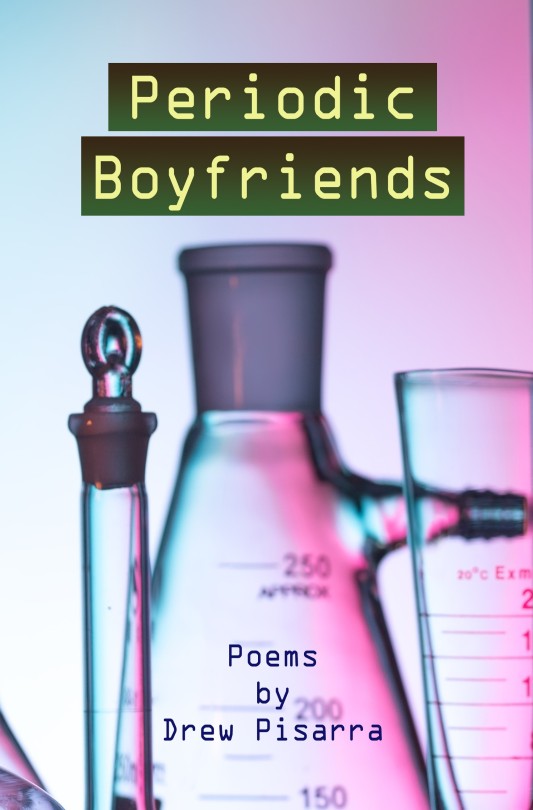
Press Roundup for Periodic Boyfriends
Analog Science Fiction & Fact: "The land of the dead, like the realm of the microscopic, may be invisible to the naked eye, but it’s still there." (interview)
Chelsea Community News: "The poems run the gamut from sneakily humorous to outright hilarity to loss and longing, and sometimes encompass all of the above in a single entry."
CultureSonar: "...a masterpiece of love, lust, loss, and acceptance."
Full House Literary: "This collection of poetry should be on your must read list."
GCN: "...strangely beautiful in its resolve."
Highland Park Poetry: "Pisarra is skilled at emulating the classic moves of the Shakespearean sonnet, deploying enjambment to dazzle his audience..."
John V’s Eclectic Avenue: "...eloquent and masterfully constructed sonnets."
Loch Raven Review: "Much like punk culture, the most provocative, daring, and honest art often comes from the LGBT+ community. Periodic Boyfriends is no exception to this rule."
The London Grip: "Rabelaisian, witty, wistful and intelligent, Drew Pisarra’s poems are a delight to read."
Misfit Magazine: "Pisarra has written a one-of a kind collection of gay 'love poems' that even a straight person can love."
Modern Literature: "...there is no time better than now for reading this voluptuous collection of sensual poetry."
Modern Literature (part 2): "Why do you always write about sex?" (interview)
Ocean State Review: "If you want to celebrate pride by reading something by a queer author that will make you laugh, gasp, and give you what the kids call 'the feels', and make you go, 'Huh? Huh!', then I highly recommend it."
Other Terrain: "The humanness of this collection is striking, that cannot be understated."
Out in Print: "These poems exist beyond their origins, all 118 of them."
Ovunque Siamo: "Pisarra shows not only a keen understanding of chemistry theory and poetic craft, but of psychology and human relationships. These poems are, by turns, incisive, beautiful, salacious, wistful, and flat-out entertaining." (not online)
Penumbra Journal of Literature and Art: "The work is sexual and heady, but brings much more than that to the table the deeper one reads."
Sacred Chickens: "It’s a rare writer who can combine laughter and tragedy, light and darkness, not only in the same poem, but in the same sentence. Drew Pisarra is that writer."
Vagabond City: "Pisarra’s poetry playfully explores a wide swath of experiences and feelings, making the collection’s specific vision all the more impressive and admirable."
The Washington Blade: "...like hanging out on a summer’s night with the acclaimed queer poet Frank O’Hara and Dorothy Parker."
Your Impossible Voice: "Everything changed for me once I’d experienced Jean Genet’s Our Lady of the Flowers." (interview)
#chelsea community news#culturesonar#john v's eclectic avenue#the london grip#gcn#sacred chickens#out in print#analog science fiction & fact#modern literature#ovunque siamo#ocean state review#the washington blade#penumbra journal of literature and art#your impossible voice#loch raven review#highland park poetry#misfit magazine#full house literary#other terrain#vagabond city
1 note
·
View note
Text
poetry outlets that support a free palestine
after finding out that the poetry foundation/POETRY magazine pulled a piece that discussed anti-zionism because they "don't want to pick a side" during the current genocide, i decided to put together a list of online outlets who are explicitly in solidarity with palestine where you can read (english-language) poetry, including, except where otherwise stated, by palestinian poets!
my criteria for this is not simply that they have published palestinian poets or pro-palestine statements in the past; i only chose outlets that, since october 7, 2023, have done one of the following:
published a solidarity statement against israeli occupation & genocide
signed onto the open letter for writers against the war on gaza and/or the open letter boycotting the poetry foundation
published content that is explicitly pro-palestine or anti-zionist, including poetry that explicitly deals with israeli occupation & genocide
shared posts that are pro-palestine on their social media accounts
fyi this is undoubtedly a very small sample. also some of these sites primarily feature nonfiction or short stories, but they do all publish poetry.
outlets that focus entirely on palestinian or SWANA (southwest asia and north africa) literature
we are not numbers, a palestinian youth-led project to write about palestinian lives
arab lit, a magazine for arabic literature in translation that is run by a crowd-funded collective
sumuo, an arab magazine, platform, and community (they appear to have a forthcoming palestine special print issue edited by leena aboutaleb and zaina alsous)
mizna, a platform for contemporary SWANA (southwest asian & north africa) lit, film, and art
the markaz review, a literary arts publication and cultural institution that curates content and programs on the greater middle east and communities in diaspora
online magazines who have published special issues of all palestinian writers (and all of them publish palestinian poets in their regular issues too)
fiyah literary magazine in december 2021, edited by nadia shammas and summer farah (if you have $6 usd to spare, proceeds from the e-book go to medical aid for palestinians)
strange horizons in march 2021, edited by rasha abdulhadi
the baffler in june 2021, curated by poet/translators fady joudah & lena khalaf tuffaha
the markaz review has two palestine-specific issues, on gaza and on palestinians in israel, currently free to download
literary hub featured palestinian poets in 2018 for the anniversary of the 1948 nakba
adi magazine, who have shifted their current (october 2023) issue to be all palestinian writers
outlets that generally seem to be pro-palestine/publish pro-palestine pieces and palestinian poetry
protean magazine (here's their solidarity statement)
poetry online (offering no-fee submissions to palestinian writers)
sundog lit (offering no-fee submissions to palestinian writers through december 1, 2023)
guernica magazine (here's a twitter thread of palestinian poetry they've published) guernica ended up publishing a zionist piece so fuck them too
split this rock (here's their solidarity statement)
the margins by the asian-american writers' workshop
the offing magazine
rusted radishes
voicemail poems
jewish currents
the drift magazine
asymptote
the poetry project
ctrl + v journal
the funambulist magazine
n+1 magazine (signed onto the open letter and they have many pro-palestine articles, but i'm not sure if they have published palestinian poets specifically)
hammer & hope (signed onto the letter but they are a new magazine only on their second issue and don't appear to have published any palestinian poets yet)
if you know others, please add them on!
4K notes
·
View notes
Text
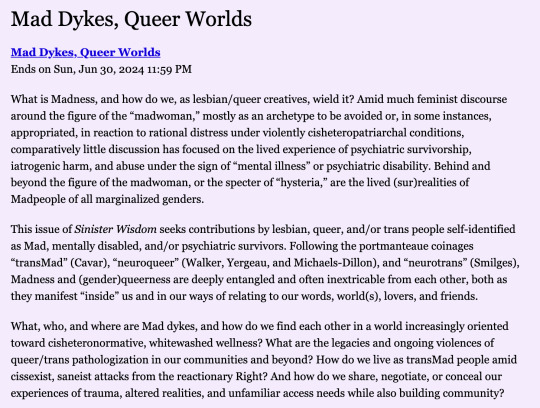
Submissions open through June 30, 2024 - Mad Dykes, Queer Worlds
Hello all! I'm editing a special issue of the literary magazine Sinister Wisdom titled Mad Dykes, Queer Worlds. If you're Mad –– regardless of personal label or diagnostic status –– and identify with some aspect of dyke experience (in all its multiplicities!), I want to consider your work for publication.
The title links to Submittable, the platform Sinister Wisdom (and most other magazines) use to process submissions. It's free to use, but can be inaccessible for visually disabled people. If that's you, email Sinister Wisdom for alternative submission options.
I am particularly interested in reading work by young/new/emerging creatives, survivors of psychiatric/medical incarceration, and/or those living outside the Global North/West. Visual art and written work are all welcome!
Note: Sinister Wisdom can't pay $; they compensate in a year-long print subscription and complementary copies of the journal. If you only submit to magazines that pay, consider checking out mine, manywor(l)ds.place; we reopen for general submissions June 1.
Feel free to email me with any further questions. Don't self-reject. ID for the image both in the alt text and below the cut.
Mad Dykes, Queer Worlds
What is Madness, and how do we, as lesbian/queer creatives, wield it? Amid much feminist discourse around the figure of the “madwoman,” mostly as an archetype to be avoided or, in some instances, appropriated, in reaction to rational distress under violently cisheteropatriarchal conditions, comparatively little discussion has focused on the lived experience of psychiatric survivorship, iatrogenic harm, and abuse under the sign of “mental illness” or psychiatric disability. Behind and beyond the figure of the madwoman, or the specter of “hysteria,” are the lived (sur)realities of Madpeople of all marginalized genders.
This issue of Sinister Wisdom seeks contributions by lesbian, queer, and/or trans people self-identified as Mad, mentally disabled, and/or psychiatric survivors. Following the portmanteaue coinages “transMad” (Cavar), “neuroqueer” (Walker, Yergeau, and Michaels-Dillon), and “neurotrans” (Smilges), Madness and (gender)queerness are deeply entangled and often inextricable from each other, both as they manifest “inside” us and in our ways of relating to our words, world(s), lovers, and friends.
What, who, and where are Mad dykes, and how do we find each other in a world increasingly oriented toward cisheteronormative, whitewashed wellness? What are the legacies and ongoing violences of queer/trans pathologization in our communities and beyond? How do we live as transMad people amid cissexist, saneist attacks from the reactionary Right? And how do we share, negotiate, or conceal our experiences of trauma, altered realities, and unfamiliar access needs while also building community?
Please submit works of any, all, or no genres, including reviews and interviews, up to 5,000 words, and a short contributor biography between 25 and 125 words. We are also seeking illustrations and photographs (.jpg or .tif files only, print resolution size at least 300 ppi). Please do not send previously published work.
Deadline for submissions: June 30, 2024
-
-
[tagging for spread hopefully! @closet-keys, @rebirthgarments, @fluoresensitive, @heavenlyyshecomes, @trans-axolotl, @fatehbaz @sawasawako @felgueirosa @bioethicists @campgender @candiedsmokedsalmon @sadhoc @osmanthusoolong @boykeats ]
#tia to everyone for sharing!!! i want to get this seen by as many ppl as possible#mine#call for submissions#madness
324 notes
·
View notes
Note
Good morning from the PNW!
You probably get a lot of asks like this, but I recently got published in my college's literary magazine and won first in prose in the related contest. Despite this very public statement from Someone Who's Not Me that I'm a talented writer, re-reading the published piece fills me with dread and self-loathing. It feels presumptuous, pretentious, purple, and a few other p-words that are less than flattering. Is that something that will go away with time, or will re-reading my work in print always be this upsetting?
Learn from it. As soon as you see what you wrote in print you see all the mistakes, all the holes, all the places you cheated. It's the best teaching tool you have, the best chance at getting better.
817 notes
·
View notes
Text
hi everyone, long time no see! coming back to tumblr with a pitch that one friend rated 12/10, another 15/10, and no one less than a 10 (that i will be mentioning for the purposes of this post).
so basically me and my girlfriend are in our final year as university undergrads, and are fighting for our lives for stuff to put on our cvs / master applications that falls in line with our degree programs and interests (english literature for both). as much as i'd like it to, 'spending well over 80 hours mapping out dnd sessions' for some reason doesn't tend to appeal to employers or admissions offices.
this is where VULTURE CULTURE comes in.
we've laid out the principal tenets on the 'about' page, but a tldr for whoever is interested:
At Vulture Culture, we aim to take the works of people they may not necessarily feel the best about, works that may not otherwise see the light of day, and give them a ‘home.’ We believe that there’s no such thing as a story not worth telling.
By not charging submission fees (be so for real) and keeping our guidelines few, we also hope to erode some of the traditional barriers in publishing, and create a more accessible space for all.
in other words, GIVE US YOUR LEFTOVERS.
we are a literary magazine that will accept anything that exists in the mid range of what you love and hate. have you ever wanted to be published but where do you even start? here. are you unsure what to do with that old work that's been sitting in your drafts forever (it's good enough to post, but not good enough to be picked up by anyone of significance)? hi.
our first issue theme is NEW BODIES, and we are just as curious as you to find out what that means. deadline is march 1st, 2024.
come help us be employable or whatever. also in return you get to clear up some draft space and see your name in print. together, love wins 🏆
#writeblr#original writing#literary magazine#writers on tumblr#vulture culture#notnow#might tag some people who i think could be interested but also that feels v tacky. so ill just throw it into the wild for now#and see who bites 🐟#also we do have people irl who we can rope into this so its a very low pressure deal here. low stakes if it flops#just thought to check anyway!
254 notes
·
View notes
Text

THURSDAY HERO: Mildred Harnack
Mildred “Mili” Harnack was a writer and academic from Wisconsin who moved to Berlin with her German husband in 1930. As Hitler rose to power, Mili created the largest resistance group in Nazi Germany and was targeted for execution by the Fuhrer himself.
Mili was born Mildred Fish in Milwaukee in 1902. Her father William was a teacher, and her mother Georgina was an activist for women’s suffrage. Mili had a natural facility with languages, and was fluent in German by the time she reached adulthood. Throughout her life, Mili loved German literature and culture. She attended the University of Wisconsin in Madison, where she majored in English literature. Mili lived in a rooming house popular with writers, and worked as a film and drama critic for a local newspaper.
After receiving her BA, Mili went on to earn an MA in English in 1925. The next year she moved back to Milwaukee and worked as a lecturer at the Milwaukee State Normal School (now the University of Wisconsin – Milwaukee.) She met Arvid Harnack, a German economist and lawyer who was studying at the university on a Rockefeller fellowship. Arvid was from a prominent family of German intellectuals. After a whirlwind love affair, they were married in August 1926 at her brother’s farm. Arvid’s fellowship ended and he returned to Germany, followed by Mili the year later, after she completed a teaching session at Goucher College in Baltimore.
In Germany, Mili worked on her doctoral thesis and lectured at universities in German cities Jena and Giessen. The country was plunging deeper into political turmoil, and the Nazi party was rising to power amid the chaos. More than half of Mili’s students were outspoken Nazis. She moved to Berlin in 1930 to be with her husband, and began working as an assistant lecturer in English and American literature at the University of Berlin. Mili lectured about her favorite English and American writers including Ralph Waldo Emerson, Walt Whitman, Thomas Hardy and George Bernard Shaw. She was so popular with students that in just a year and a half, enrollment in the class tripled.
Mili connected with other American expatriates in Berlin and formed a literary salon where anti-Nazi academics and intellectuals could express themselves freely. By 1934, the Nazi secret police were everywhere and the salon was disbanded. Fellow ex-pat Martha Dodd, a close friend of Mili’s, later described her Berlin salon as “the last of the meager remnants of free thought.” Many of those who had participated in the salons continued to meet in the Harnacks’ living room but instead of discussing literature, they planned anti-Nazi political activism
Meanwhile, Mili achieved renown as a writer. She published essays in prominent German literary journals until the mid-30’s, when magazines started to print only “approved opinions” (in support of Hitler). She was able to continue working as a translator, and her German-language translation of Irving Stone’s biography of Vincent van Gogh, Lust for Life, was published in 1936.
Mili returned to the U.S. on a book tour in 1937, and her old friends were shocked at the drastic change in her personality. Earlier she had been friendly and easy-going, but four years living under Nazi rule made Mili anxious, stiff and guarded. She’d had to wear a metaphorical mask to survive in the totalitarian German state, and couldn’t shed the mask even when she left Europe. Mili’s family urged her to stay in the U.S. but she was determined to return to her husband and her political activism group, now called “The Circle.”
Mili’s unassuming manner combined with an extremely sharp intellect enabled her to penetrate the highest circles of German politics and diplomacy. She used these connections to get exit and travel visas for Jewish friends and colleagues, among them prominent publisher Max Tau. Mili also surreptitiously gleaned information from highly placed contacts, which she transmitted to fellow members of the resistance.
Mildred was fired from her teaching job at the University of Berlin because of her political beliefs, and she began teaching at night school, where her students were mostly working class or unemployed. She recruited many of them to join The Circle. The group published anti-Nazi leaflets, written by Mildred, and secretly left stacks of them in public places throughout the city.
German intelligence called them “the Red Orchestra” and falsely smeared them as communists working for the Soviets. Undeterred, the group increased their activities and cooperated with other resistance units. Around this time Mili wrote, “I saw it clearly before my eyes. From then on our work not only implies the risk of losing our freedom, from now on death was a possibility.” Led by Mili, The Circle became the largest resistance group in Nazi Germany. They incited civil disobedience against the Nazi regime, documented Nazi atrocities, and transmitted military intelligence to the Allies.
In the summer of 1942, the Nazis intercepted radio transmissions that revealed the identity of prominent resistance fighters including the Harnacks. On September 7, Mili and Arvid were arrested by the Gestapo and imprisoned. Arvid was tried by the Reich Military Tribunal and sentenced to death on December 19. He was hanged three days later at Plotzensee Prison.
Mili languished in a squalid prison cell for months, where she was tortured and contracted tuberculosis. She went on trial and was sentenced to six years in prison. However, Hitler heard about the American woman who fought so effectively against his regime, and he ordered a new trial for Mili. The kangaroo court delivered a pre-determined death sentence, and at Hitler’s explicit request Mili was beheaded by guillotine on February 16, 1943. Her last words were, “And I have loved Germany so much!” After her execution, Mili’s body was given to an anatomy professor at Humboldt University to dissect for research. After he finished, he gave the rest of her remains to a friend of hers, who had Mili buried in Zehlendorf Cemetery in Berlin.
The only writing that survived from her time in prison were a few translated lines from Goethe: “In all the frequent troubles of our days/A God gave compensation – more his praise/In looking sky-and heavenward as duty/In sunshine and in virtue and in beauty.”
Mildred’s brave actions and tragic death have not been forgotten. In Berlin, a street and a school are named for her, and in her native Wisconsin schools observe Mildred Fish Harnack Day. The University of Wisconsin-Madison hosts an annual Mildred Fish-Harnack Human RIghts and Democracy Lecture, and a sculpture of Mili was unveiled in Madison in 2019.
For fighting Hitler at the cost of her own life, we honor Mildred Harnack as this week’s Thursday Hero.
Image: Gestapo mug shots of Mildred taken after her arrest in 1942.
87 notes
·
View notes
Text
Another big stop in Tokyo for me was Jimbocho Book Town! It is a neighborhood of, depending on who you ask, up to 400 generally-secondhand bookstores flanked by some of the major universities in Tokyo. The local government even prints out maps of the stores to help people find them all:

Which, you will note, is not 400 stores, because the process of becoming an "official" Jimbocho Town Bookstore is an intensely political operation run by local stakeholders with tons of fights over what should qualify and what rights that entails - never change humanity!
"Book Towns" used to actually be quite a common thing, and they peaked during the literary boom of the late 19th century. Figuring out "what books existed" was a hard task, and to do serious research you needed to own the books (you weren't making photocopies), so concentrating specialty bookstores in one area made sense to allow someone to go to one place and ask around to find what they need and discover what exists. It was academia's version of Comiket! Modern digital information & distribution networks slowly killed or at least reduced these districts in places like Paris or London, but Jimbocho is one of the few that still survives.
Why it has is multi-causal for sure - half of this story is that Tokyo is YIMBY paradise and has constantly built new buildings to meet demand so rents have been kept down, allowing low-margin, individually-owned operations to continue where they have struggled in places like the US. These stores don't make much money but they don't have to. But as important is that Japan has a very strong 'book collector' culture, it's the original baseball cards for a lot of people. The "organic" demand for a 1960's shoujo magazine or porcelainware picture book is low, but hobbyists building collections is a whole new source of interest. Book-as-art-collection powered Jimbocho through until the 21st century, where - again like Comiket - the 'spectacle' could give it a lift and allow the area to become a tourist attraction and a mecca for the ~cozy book hoarder aesthetic~ to take over. Now it can exist on its vibes, which go so far as to be government-recognized: In 2001 the "scent wafting from the pages of the secondhand bookstore" was added to Japan's Ministry of Environment's List of 100 Fragrance Landscapes.
Of course this transition has changed what it sells; when it first began in the Meiji area, Jimbocho served the growing universities flanking it, and was a hotpot of academic (and political-polemic) texts. Those stores still exist, but as universities built libraries and then digital collections, the hobby world has taken over. Which comes back to me, baby! If you want Old Anime Books Jimbocho is one of the best places to go - the list of "subculture" stores is expansive.
I'll highlight two here: the first store I went to was Kudan Shobo, a 3rd floor walk-up specializing in shoujo manga. And my guys, the ~vibes~ of this store. It has this little sign outside pointing you up the stairs with the cutest book angel logo:
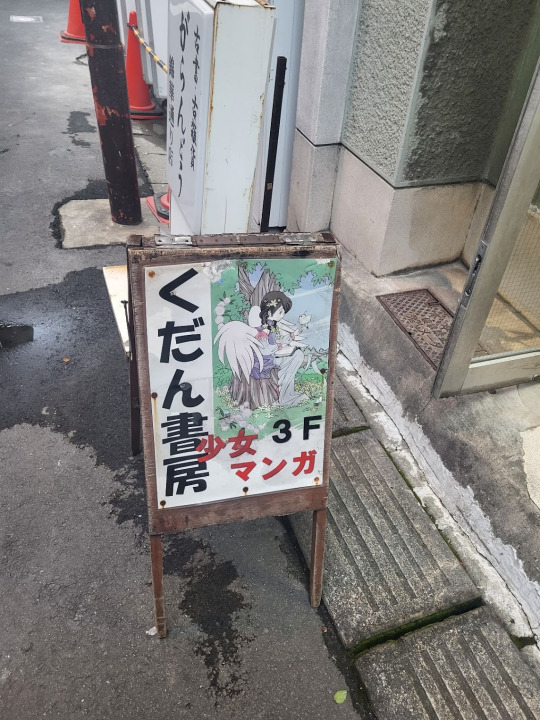
And the stairs:
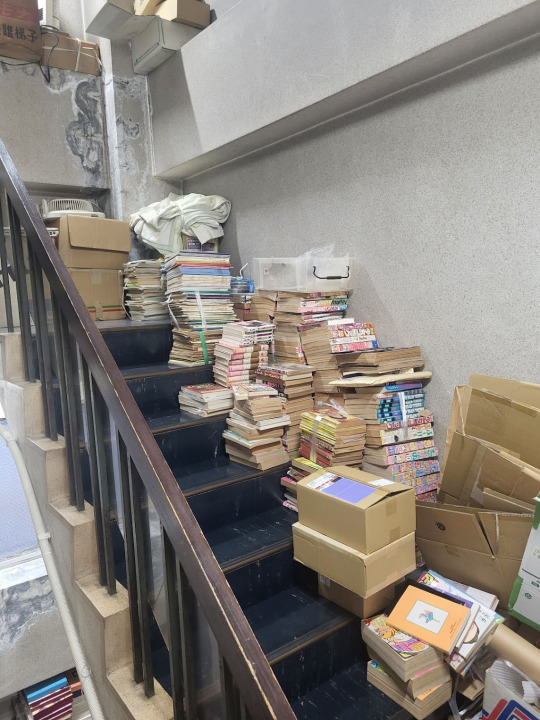
Real flex of Japan's low crime status btw. Inside is jam-packed shelves and the owner just sitting there eating dinner, so I didn't take any photos inside, but not only did it have a great collection of fully-complete shoujo magazines going back to the 1970's, it had a ton of "meta" books on shoujo & anime, even a doujinshi collection focusing on 'commentary on the otaku scene' style publications. Every Jimbocho store just has their own unique collection, and you can only discover it by visiting. I picked up two books here (will showcase some of the buys in another post).
The other great ~subculture~ store I went to was Yumeno Shoten - and this is the store I would recommend to any otaku visiting, it was a much broader collection while still having a ton of niche stuff. The vibes continued to be immaculate of course:
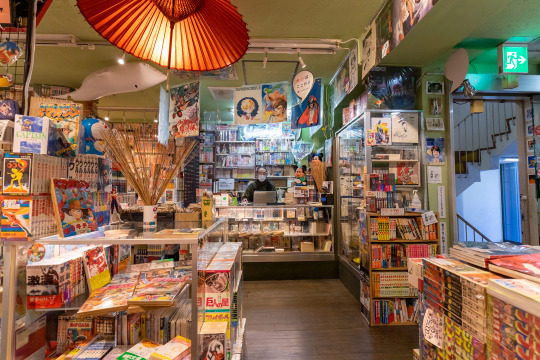
And they covered every category you could imagine - Newtype-style news magazine, anime cels, artbooks, off-beat serial manga magazines, 1st edition prints, just everything. They had promotional posters from Mushi Pro-era productions like Cleopatra, nothing was out of reach. I got a ton of books here - it was one of the first stores I visited on my second day in Jimobocho, which made me *heavily* weighed down for the subsequent explorations, a rookie mistake for sure. There are adorable book-themed hotels and hostels in Jimbocho, and I absolutely could see a trip where you just shop here for a week and stay nearby so you can drop off your haul as you go.
We went to other great stores - I was on the lookout for some 90's era photography stuff, particularly by youth punk photographer Hiromix (#FLCL database), and I got very close at fashion/photography store Komiyama Shoten but never quite got what I was looking for. Shinsendo Shoten is a bookstore devoted entirely to the "railway and industrial history of Japan" and an extensive map collection, it was my kind of fetish art. My partner @darktypedreams found two old copies of the fashion magazine Gothic & Lolita Bible, uh, somewhere, we checked like five places and I don't remember which finally had it! And we also visited Aratama Shoten, a store collecting vintage pornography with a gigantic section on old BDSM works that was very much up her alley. It had the porn price premium so we didn't buy anything, but it was delightful to look through works on bondage and non-con from as far back as the 1960's, where honestly the line between "this is just for the fetish" and "this is authentic gender politics" was...sometimes very blurry. No photos of this one for very obvious reasons.
Jimbocho absolutely earned its rep, its an extremely stellar example of how history, culture, and uh land use policy can build something in one place that seems impossible in another operating under a different set of those forces. Definitely one of the highlights of the trip.
290 notes
·
View notes
Text
I know there's a lot to unpack in James' new interview but I am feral, FERAL I SAY, over this fucking line right here:
"His need was to be loved, and his tragic flaw was the belief that he was unlovable."
Back before Season 3 hit and Tedependent became ~trendy~ (not actually lol) I was heacanoning and writing Trent as a pretty anxious individual, someone with a ton of internalized self-loathing whose "whole vibe" was more of a mask than legitimate self-confidence. At the time I worried about him coming across as too OOC because really, what did we have to support this? Ted Lasso's prevailing theme of men discovering love and support when they previously had none? The lovely parallel of Trent struggling with many of Ted's own flaws, but presenting in opposite ways (cutting cynicism vs. endless optimism)? The then—far less developed—comments from James that Trent might have a rough relationship with his father? It felt unsubstantiated, unpersuasive, built more on my own interest in those kinds of characters and the occasional awkward moment from Trent than actual canon. Even into Season 3 I questioned whether my reading of him as struggling, significantly, with the care Ted offers wasn't just a result of my own, imagined inner life for him.
But NOW.
I'm sorry, hold up, can I just re-confirm that TRENT'S TRAGIC FLAW IS HIS BELIEF THAT HE'S UNLOVABLE? Unlovable??? Thank you, James Lance, for validating every reading I've had of this character since he first appeared on screen. Do people realize the depth this adds to every interaction Trent has? Particularly with Ted? Unlovable Trent Crimm starts off this relationship with a sincere compliment on his style ("I like your glasses"), something that Season 3 will present as a core part of his personality, something he's largely hidden away. Unlovable Trent Crimm grappling with the fact that yes, Ted enjoyed spending time with him. Him. WHILE he was playing the part of the asshole journalist. Unlovable Trent not being rejected when he admits, in moments of vulnerability, that he "Loves [their] chats." Unlovable Trent having his father's (likely snide) "Independent" comment reframed as a fun pun + advice to follow his "bliss": you have support, Trent, no matter what you choose to do. I don't care if you're successful covering a masculine-coded sport, I care if you're happy. Unlovable Trent committing the ultimate betrayal and being forgiven for it, immediately. Unlovable Trent being forcibly integrated into the Richmond family; actively accepted rather than passively tolerated: yes you should work here, yes you're a Diamond Dog, sit your butt down, Trenthouse Magazine, you will never be excluded again.
I'm sorry for the rambling post but I'm just so!! Insane about this!!! So much of Trent's hesitance could have been written off as a result of his career. That is, it might have been merely a learned reaction after decades of deliberately pissing people off. Of course they dislike him, but take him out of that environment and everything's fixed. Yet James has confirmed that he played Trent as intrinsically believing this. The career was a result of that unfounded fear—Might as well keep people at a distance before they hurt me first—as well as, simultaneously, a desire to somehow achieve the love that should have been unconditional from the start—Maybe my father will like me if I can be that "alpha male man's man" in print. Because this isn't just a flaw, it's a tragic flaw, a literary term that denotes a deficiency that leads to the character's downfall. This belief is so entrenched that it has led to Trent actively self-sabotaging his chances of being loved in the first place; a horrible self-fulfilling prophecy. He NEEDED someone like Ted—a fucking love sledgehammer that forces people to accept his care in the least subtle ways possible, even when they're acting as their own worst enemy—and by god, he got him!
Aside from Nate, Trent has always felt like the most isolated character to me at the start of the series (and even Nate has a good relationship with his mother and sister). What we've learned in Season 3 and James' interviews has only reinforced that reading for me: he was closeted in his marriage, unintentionally hurting his daughter, he's suffering under his father's expectations, he hates the press persona he's created to survive, he's bored at his job, footballers and other potential interviewees despise him—and not without reason (Roy). He has no friends that we see pre-Richmond and he's reached a point where the simple act of someone saying that they liked spending the day with him—again, while he's actively TRYING to piss them off and keep his distance—has him in such a state of shock he runs for the door, pens an uncharacteristically hopeful write-up, and is well on his way to upending his entire life for that man.
Because of course he is!!! From Trent's perspective Ted is a fucking impossibility shaped into human form. This is a man in his 40s whose greatest lifelong fear—now all but a certainty at his age—has been dismantled in a matter of hours. I'd write a book-length love letter to him too! And RIP to finale!Trent, but I would have run fucking Rom-Com style after the man who not only changed my life, but my entire sense of self-worth. (Ah fuck, but there's that tragic flaw again, keeping Trent hesitant. I now stand by my reading of the "I'll leave you be" scene as an unrequited goodbye.)
But finale aside, the man who'd convinced himself he was unlovable fell for the man who was love incarnate.
If that's not the most romantic shit you've ever heard idk what is!!!
251 notes
·
View notes
Text
a Belarusian investigative journalist, essayist and oral historian who writes in Russian. She was awarded the 2015 Nobel Prize in Literature "for her polyphonic writings, a monument to suffering and courage in our time".
Her first book, War's Unwomanly Face, came out in 1985. It was repeatedly reprinted and sold more than two million copies. The book was finished in 1983 and published (in short edition) in Oktyabr, a Soviet monthly literary magazine, in February 1984. In 1985, the book was published by several publishers, and the number of printed copies reached 2,000,000 in the next five years. This non-fiction oral history book is made up of monologues of women in the war speaking about the aspects of World War II that had never been related before.
She has been described as the first journalist to receive the Nobel Prize in Literature.
71 notes
·
View notes
Text
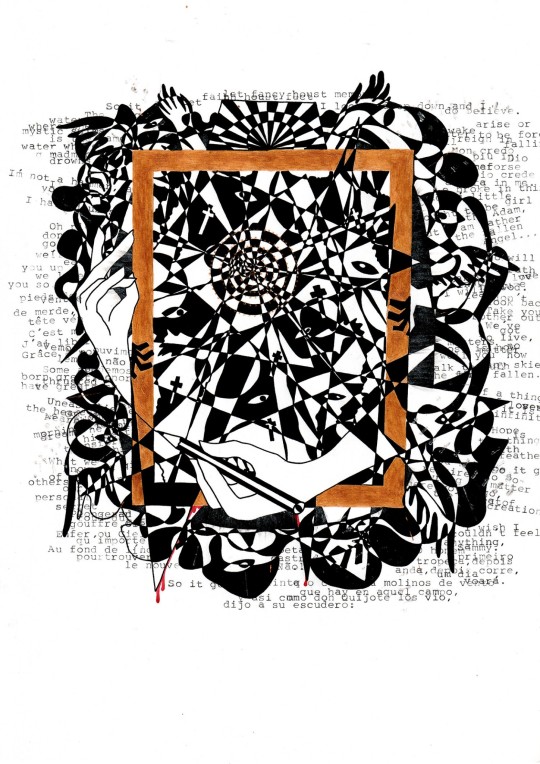






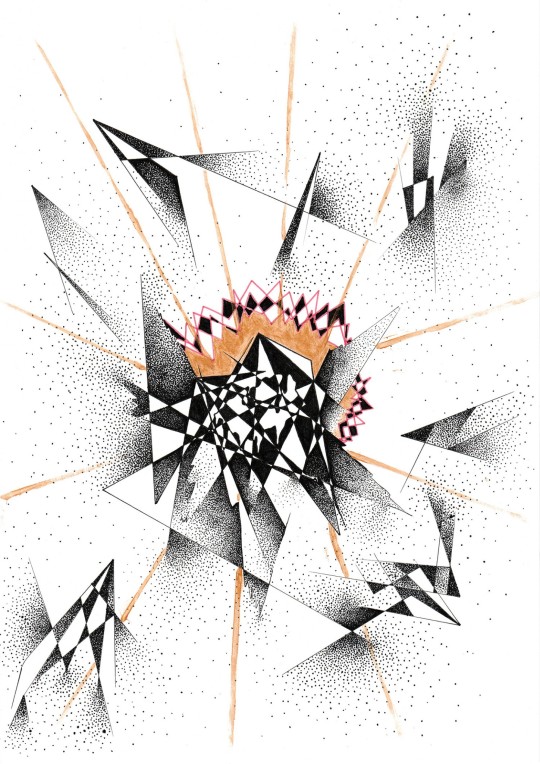
Just did a post for #PortfolioDay on twitter and I'm gonna do it here too. Hi hello I'm Carolina and I'm a Portuguese lover of small intricate things making art with mostly ink pens and acrylics, and occasionally getting it published in literary magazines! Prints for sale as well, check my pinned post!
#portfolio day#Portfolioday#Follow me on twitter for the occasional art and also sometimes stamps movie takes and bugs#Art#Abstract art#Kinda#I never know what tags to use#Mine.caro#Also i havent posted anything new in ages but i will! I will!#And yes i didnt mention its inspired by spnbfhsdj im curious to see how it comes off without that context#Forgot to add the prints thingbshdj
168 notes
·
View notes
Text

LITERARY MAGAZINE CULTURE HELL FOREVER VOLUME 1: "The First Insult"
A magazine by small carnivorous birds, for small carnivorous birds.
Rome, dogs, John Wick, flesh-machines, cola.
"Orson Welles lives!" -Orson Welles
"FUck it we ball. Hpress the button" -ruby
DOWNLOAD/PRINT FOR FREE:
72 notes
·
View notes
Text


Today's art/literary history lesson is on: Aubrey Beardsley
Beardsley's illustration forms the background for A Power Unbound, which is a cool moment of historical connection and intertextuality
Aubrey Beardsley was a turn-of-the-century artist who was part of the Aesthetic/Decadent movements that challenged Victorian social norms in art and literature. Queerness and eroticism were significant components of these movements, which often incorporated sensation, transgression, and sexuality.
Beardsley's art was considered provocative for its use of the grotesque, the sexual, and the androgynous. (Notably, he drove his editors bonkers by always hiding dicks and other phallic silhouettes in his art.)
Beardsley was the art editor for The Yellow Book, a literary journal printed in the 1890s. It was so named because of its intentionally garish yellow cover, which was meant to mimic the style of lewd French texts.
However, Beardsley is probably best remembered today for his illustrations that accompanied Oscar Wilde's controversial play Salomé. Although Wilde himself was not involved with The Yellow Book, his association with Beardsley through Salomé was so well known that The Yellow Book forced Beardsley out of his position as art editor following Wilde's trial; The Yellow Book did not last much longer after that. Aestheticism overall suffered in the wake of Wilde's trial specifically because of its association with Wilde and queer, transgressive artists.
But, given Beardsley's artistic ethos and the inextricable queerness of those movements as a whole, Beardsley's Decadent art is a fitting choice for the cover of A Power Unbound—which is itself a celebration of unapologetically queer and sexual art (and features its own lewd publications with notably colored covers 😉).
--
If you're interested in Beardsley or Decadence/Aestheticism and want to read more, here's a reference list (I'm happy to share PDFs—just let me know!):
Kaye, Richard. 2019. “Aestheticism and Decadence, Nineteenth-Century.” In Global Encyclopedia of Lesbian, Gay, Bisexual, Transgender, and Queer (LGBTQ) History: A-F.
Glick, Elisa. 2014. “Turn-of-the-Century Decadence and Aestheticism.” In The Cambridge History of Gay and Lesbian Literature, 325–43. Cambridge: Cambridge University Press. https://doi.org/10.1017/CHO9781139547376.023.
Brake, Laurel. 2013. “Aestheticism and Decadence: The Yellow Book (1894–7), The Chameleon (1894), and The Savoy (1896).” In The Oxford Critical and Cultural History of Modernist Magazines: Volume I: Britain and Ireland 1880-1955. https://doi.org/10.1093/acprof:osobl/9780199654291.003.0006
Denisoff, Dennis. 2007. “Decadence and Aestheticism.” In The Cambridge Companion to the Fin de Siècle, 31–53. Cambridge: Cambridge University Press. https://doi.org/10.1017/CCOL9780521850636.003
#the last binding#a power unbound#aubrey beardsley#aestheticism#freya marske#I really like Aestheticism and Decadence as a literary movements#so I just uh. read about them a lot For Funsies#.pdf
26 notes
·
View notes